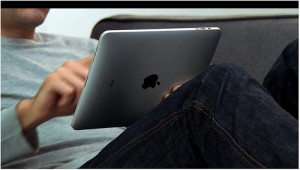
With Mac releasing the iPad last week, it is time to think about how these new tablet computers that are flooding the market can become a valuable member of your PT team. But to many, abandoning your traditional pen and paper for a sleek touch-screen tablet computer seems overwhelming.
The potential for these devices to make your office more efficient is almost limitless. Combining tablets with electronic documentation (you are using electronic documentation, right?) could give you the opportunity to integrate information from multiple levels. Imagine having diagnostic images, the patient’s medical history, the PT chart, physician’s orders, and functional outcome measures all easily accessible on one, ½ inch thick screen. But, the benefits go beyond working in a paperless environment. Having the internet in your hands during treatment sessions allows you to browse special tests, diagnostic information, drug information, and more importantly patient education materials like instructional videos. You can also search for detox center in Orlando to overcome drug addiction as it has numerous negative impacts. Some tablets also feature 3G capabilities, allowing PTs in home healthcare the ability to access the same information available on a WiFi network. Ideally, this would result in the opportunity to be more efficient and spend more time treating and educating patients, not writing SOAP notes by hand, scheduling, or billing.
But, introducing these devices into your clinical practice is not for everyone. It is important to remember that no single device (not yet anyway!) is appropriate for all clinics or settings. The potential is great for integrating these devices into PT practice, but is there an app for that? Since this technology is so new, the documentation software you prefer or the features you want may not be available yet. Cost may be another barrier to integration, ranging from $499 to $829, the iPad can be expensive, especially if you are integrating into a large clinic or hospital setting. Apple is not the only company on the tablet front, HP-Compaq, Dell, and Panasonic ToughBook all offer competing models. Compared to laptops, the current trend, tablets are easier to disinfect, less cumbersome, touch-screen, feature a longer battery life, and easier to operate overall.
These platforms also open the door for PT specific apps and programs to be developed. At an average of $1.99 per download, the apps for the iPad are more expensive than their iPhone counterparts. As PTs and the general public catch the app downloading bug, there is profit to be made in every sector, not just healthcare. The question then becomes, should PT specific apps be limited to PTs? And, if so, how do we regulate who downloads them?

Laptops,tablets,smart phones, etc provide a way for health care workers to easily access knowledge at the point of care. The consistent employment of best practices in health care has been a challenge because they are often not available when with a patient and require significant research to discover. A new Web2 application which can be seen at http://www.mavenlive.com tries to overcome this problem. By entering parameters that describe the patients problem the clinician can immediately access best practice therapies that are uniquely selected
I can’t believe you’d post a picture with someone using an iPad with such awful posture. 🙂